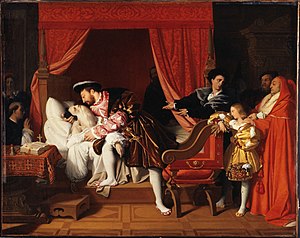The Death of Leonardo da Vinci
| The Death of Leonardo da Vinci | |
|---|---|
| Francis I Receives the Last Breaths of Leonardo da Vinci | |
 | |
| Artist | Jean-Auguste-Dominique Ingres |
| Year | 1818 |
| Medium | oil paint, canvas |
| Dimensions | 40, 40, 72 cm (16, 16, 28 in) × 50.5, 81.5 cm (19.9, 32.1 in) × 8.5 cm (3.3 in) |
| Location | Petit Palais |
| Commissioned by | Pierre Louis Jean Casimir de Blacas |
| Collection | Musée des Beaux-Arts de la ville de Paris |
| Accession No. | PDUT1165 |
The Death of Leonardo da Vinci or Francis I Receives the Last Breaths of Leonardo da Vinci is an 1818 oil painting by the French artist Jean-Auguste-Dominique Ingres, showing the Italian artist and inventor Leonardo da Vinci dying, with Francis I of France holding his head. It was commissioned by Pierre Louis Jean Casimir de Blacas, the French ambassador in Rome, and is now in the Petit Palais in Paris.[1]
Another version of the painting created c. 1851 is held by the Smith College Museum of Art.[2]
Description
[edit]The painting depicts the death of the Italian Renaissance polymath Leonardo da Vinci, which took place in the Clos Lucé house, in Amboise, on May 2, 1519. As a source of inspiration for this painting, Ingres took up the story of the death of the painter present in the Lives of Giorgio Vasari. The king of France Francis I embraces the dying artist to receive his last breath, while other characters, including priests and servants, observe the scene. The young dauphin Francis of Valois sadly observes the scene and a cardinal places a hand on his shoulder to comfort him. On a table next to Leonardo's bed are a Bible and a small crucifix. The face of Francis I takes up a painting by Titian dating back to 1538.[3]
See also
[edit]References
[edit]- ^ "Francis I Receives the Last Breaths of Leonardo da Vinci". Petit Palais. Retrieved March 25, 2021.
- ^ "Death of Leonardo da Vinci". National Gallery of Art. Retrieved March 25, 2021.
- ^ van Wijck, Frank (2021-10-28). "De overeenkomst tussen Leonardo da Vinci en het tandartsvak". Tandartspraktijk. 42 (7): 29–31. doi:10.1007/s12496-021-0085-6. ISSN 0167-1685. S2CID 240303453.

